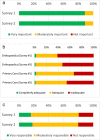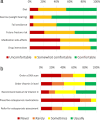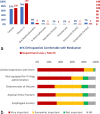Orthopedic surgeons' views on the osteoporosis care gap and potential solutions: survey results
- PMID: 30841897
- PMCID: PMC6402163
- DOI: 10.1186/s13018-019-1103-3
Orthopedic surgeons' views on the osteoporosis care gap and potential solutions: survey results
Abstract
Introduction: Osteoporosis is often not recognized until one or more fractures occur, yet post-fracture screening remains uncommon. Orthopedic surgeons are well situated to address this care gap. Both a protocol-based approach and fracture liaison services (FLS) have been proposed. The present surveys assess orthopedists' attitudes to these alternative models for addressing this care gap.
Methods: Two digital surveys were sent to all orthopedic surgeons and orthopedic midlevel providers at a large level 1 trauma center 1.5 years apart.
Results: Thirty-six of 47 survey recipients (77%) responded to the first survey; all 55 recipients (100%) responded to the second. Respondents recognized the importance of osteoporosis care, the inadequacy of current measures, and the potential of orthopedic surgeons to help address this gap. Respondents reported regular encounters with fragility fracture patients but limited familiarity with core aspects of osteoporosis screening and treatment, especially pharmacotherapy. While some respondents (40%) reported willingness to attempt a protocol-based approach to addressing this care gap, many others expressed reservations (60%) and support for a FLS-based approach was much higher (95%).
Conclusions: A fracture liaison service model best fits the observed attitudes of orthopedic surgeons at this level 1 trauma center relative to a protocol-based approach. Protocol-based approaches may be preferable in alternate settings.
Keywords: FLS; Fracture liaison service; Fracture prevention; Fragility fracture; Osteoporosis; Protocol; Quality improvement; Survey.
Conflict of interest statement
Ethics approval and consent to participate
This study was ruled exempt by the Carilion Clinic Institutional Review Board. Participation in the survey was completely voluntary.
Consent for publication
The hospital IRB ruled that informed consent was not necessary for this study as it did not meet the criteria for human subjects research given its focus on expert opinions. As such, specific participant consent for publication is not required.
Competing interests
The authors declare that they have no competing interests. The first and senior authors have a complementary interest as they were involved in the planning and implementation of the fracture liaison service at our institution.
Publisher’s Note
Springer Nature remains neutral with regard to jurisdictional claims in published maps and institutional affiliations.
Figures







References
-
- NCQA. Osteoporosis testing and management in older women. Washington, D.C: National Center for Quality Assurance; 2017.
-
- AOA. Own the bone. http://www.ownthebone.org/. Accessed 27 Feb 2018.
-
- Capture the fracture. http://www.capturethefracture.org/. Accessed 27 Feb 2018.
MeSH terms
Substances
Grants and funding
LinkOut - more resources
Full Text Sources
Medical
Miscellaneous

